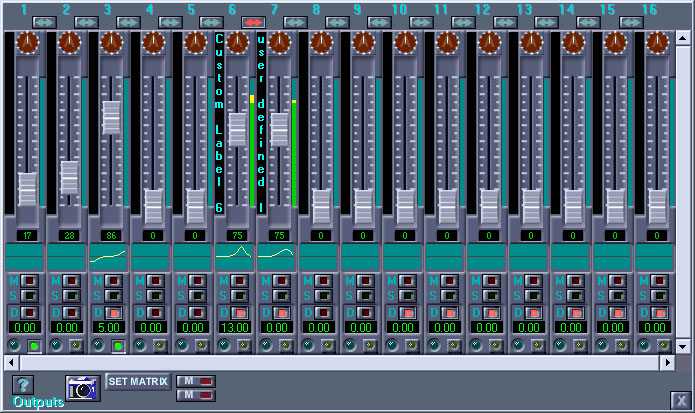
RSD's ABEdit Software - Output Window

The output window is from where output levels are set and monitored. The window itself resembles an output channel on a standard mixing console with a few exceptions.
![]() This button links the faders it is sitting between. Red means the faders are
linked. In order to link faders that are not next
to each other, click on the green LED
This button links the faders it is sitting between. Red means the faders are
linked. In order to link faders that are not next
to each other, click on the green LED
at the bottom of the desired faders to be linked. You will notice that channels
8,11,13, &14 are linked in the diagram.
The M,S, and D stand for Mute, Solo, and Delay respectively. The number below the D corresponds to milliseconds.
The seemingly floating "124" on the fader corresponds to the location of the mouse and if double-clicked, the fader will move to that level (0-127)
![]() This button is the Auto-Pan knob which is where the fade time can be changed.
This button is the Auto-Pan knob which is where the fade time can be changed.
When this icon is double-clicked, this window appears:

Hours, minutes, seconds, fraction of seconds.
The two types of fades are table (or linear) and exponential.
![]() This icon corresponds to the EQ setting currently active which is discussed in
greater detail in the
EQ
section.
This icon corresponds to the EQ setting currently active which is discussed in
greater detail in the
EQ
section.
![]() The camera icon is the snapshot button which will is discussed in greater
detail in the
snapshot
section.
The camera icon is the snapshot button which will is discussed in greater
detail in the
snapshot
section.
The Set Matrix button will open this window:
This window allows you to quickly set up the mixers to some frequently used presets.
AudioBox, ShowMan, E-Show, AUTO-PAN and MIDIShowCD are Trademarks of Richmond
Sound Design
All other trademarks are acknowledged.
Subject to change without notice.
Copyright ©2007
Richmond Sound Design - Theatre Sound Design & Show Control
Last modified:
2007-03-17